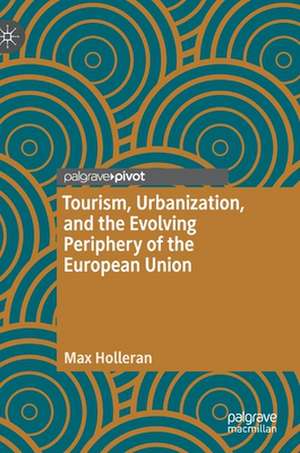Tourism, Urbanization, and the Evolving Periphery of the European Union
Autor Max Holleranen Limba Engleză Hardback – 12 noi 2019
Preț: 417.14 lei
Nou
Puncte Express: 626
Preț estimativ în valută:
79.83€ • 82.87$ • 66.56£
79.83€ • 82.87$ • 66.56£
Carte tipărită la comandă
Livrare economică 22 martie-05 aprilie
Preluare comenzi: 021 569.72.76
Specificații
ISBN-13: 9789811502170
ISBN-10: 981150217X
Pagini: 124
Ilustrații: XI, 124 p. 4 illus.
Dimensiuni: 148 x 210 mm
Greutate: 0.32 kg
Ediția:1st ed. 2020
Editura: Springer Nature Singapore
Colecția Palgrave Pivot
Locul publicării:Singapore, Singapore
ISBN-10: 981150217X
Pagini: 124
Ilustrații: XI, 124 p. 4 illus.
Dimensiuni: 148 x 210 mm
Greutate: 0.32 kg
Ediția:1st ed. 2020
Editura: Springer Nature Singapore
Colecția Palgrave Pivot
Locul publicării:Singapore, Singapore
Cuprins
Chapter 1 Introduction.- Chapter 2 Tourism and Europe’s Shifting Periphery: Post-Franco Spain and Post-Socialist Bulgaria.- Chapter 3 Coasts of Aspiration: Climbing the Tourism ‘Ladder’.- Chapter 4 Leisure Spaces and the Aesthetics of Europe.- Chapter 5 Conclusion: Returning to Peripherality: the Social Experience of Urban Crisis.
Notă biografică
Max Holleran is Lecturer in Sociology at the University of Melbourne. He has written about housing, architectural aesthetics, post-socialist urban planning, and European Union integration for anthropology, sociology, and history journals as well as for Boston Review, Dissent, Los Angeles Review of Books, New Republic, Slate, and the Times Literary Supplement.
Textul de pe ultima copertă
This book explores travel, tourism, and urban development at the edges of Europe from the 1970s until the present. It compares tourism-spurred urban growth in Spain and Bulgaria, showing how development in Southern Europe after the fall of dictatorships provided a model for integrating post-socialist Europe in the 1990s. It analyzes the economic, cultural, and political dimensions of tourist economies, showing how they aligned with major European Union integration goals and were supported with EU development funds. It also chronicles the social and environmental costs of mass tourism where over-development has despoiled beachfronts and promoted low paying service jobs, reinforcing regional divisions in Europe between those who host and those who visit. Ultimately, it argues that while mass tourism is touted as a viable economic solution to EU inequality, it can potentially exacerbate disparities between core and peripheral zones, creating new and troubling forms of regional polarization.
Caracteristici
Develops a unique method to establish an analytically precise connection between the making of European identity and the administrative apparatus of the European Union. Adds new perspective by showing that the process of European enlargement does not end when new member states are added, but rather that the process of integrating newly added states raises specific new challenges. Offer an original contribution to the body of literature connecting the Southern European democratic transitions to those of post-socialist East-Central Europe.
